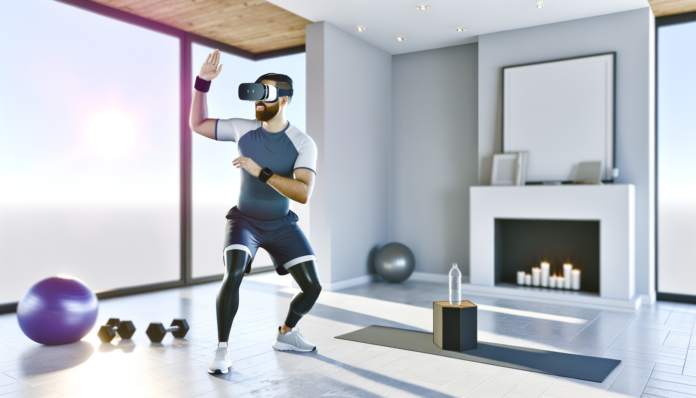
Introduction to Virtual Reality Fitness
The Evolution of Personal Fitness
Personal fitness has undergone a remarkable transformation over the decades, evolving from traditional gym-based workouts to the incorporation of technology in exercise routines. The concept of exergaming, which blends video games with physical activity, marked a significant milestone in this evolution. Starting with rudimentary interfaces in the 1980s, the industry saw a surge in popularity with the release of games like Dance Dance Revolution and later, the Wii Fit. These platforms laid the groundwork for a new era of interactive fitness, one that is now being redefined by the advent of Virtual Reality (VR).
Virtual Reality: A New Frontier in Exercise
Virtual Reality has emerged as a groundbreaking tool in the realm of personal fitness. With the release of consumer-friendly VR headsets like the Oculus Rift, VR fitness has transitioned from a niche luxury to an accessible option for the masses. VR fitness companies are now making significant strides, offering experiences that range from high-intensity workouts to meditative yoga sessions, all within the comfort of one’s home. The immersive nature of VR allows users to engage in physical activity while exploring virtual environments, turning what was once a monotonous task into an exciting adventure.
The Appeal of VR Workouts
The allure of VR workouts lies in their ability to combine the thrill of gaming with the benefits of exercise. Users report that VR fitness programs, such as those offered by Supernatural, provide an enjoyable and effective way to stay active. These workouts are designed to be so engaging that users often lose track of the effort they’re exerting, leading to more intense and satisfying sessions. The convenience of working out at home, coupled with the personalized guidance of virtual coaches and the social aspects of online communities, makes VR workouts an appealing alternative to traditional fitness methods.
Moreover, VR fitness is not just about entertainment; it’s about results. Studies have shown that VR exercise can have a positive effect on physical fitness, muscle strength, and mental well-being. The immersive experience can also reduce the perception of pain and effort, making it easier for individuals to push through challenging workouts. With the fitness market rapidly embracing VR, it’s clear that virtual gyms are not just a passing trend but a significant development in the future of personal fitness.
The Mechanics of VR Fitness
How VR Fitness Works
Virtual Reality (VR) fitness harnesses the immersive power of VR technology to create engaging and interactive workout experiences. By donning a VR headset, users are transported into a digital world where physical activity is intertwined with gameplay. The user’s movements are tracked by the VR system, allowing for real-time interaction with the virtual environment. This could involve anything from shadow boxing against a virtual opponent to dancing through a rhythm game. The key is that these activities require the user to move their body, often in ways that exercise various muscle groups and provide cardiovascular benefits.
The Role of Immersion and Gamification
Immersion and gamification are pivotal in VR fitness, transforming mundane exercise routines into captivating and enjoyable experiences. Immersion is achieved through a convincing virtual environment that engages the senses, making users feel as though they are truly part of another world. Gamification adds an element of play, incorporating goals, scores, and levels to motivate users. This combination not only makes workouts more enjoyable but also taps into the human desire for achievement and progress, which can lead to increased motivation and adherence to fitness regimens.
- Immersion: By creating a visually and audibly engaging environment, VR fitness makes users more likely to forget they are exercising, reducing perceived effort and increasing the duration of workouts.
- Gamification: Elements such as points, leaderboards, and rewards incentivize users to push their limits and keep returning to the VR fitness experience.
Tracking Progress and Performance
VR fitness platforms often include systems for tracking progress and performance, providing users with valuable feedback on their fitness journey. This can include metrics such as calories burned, time spent exercising, and completion of fitness goals. Some VR fitness applications can even track form and technique, offering suggestions for improvement. This data can be crucial for users to see tangible evidence of their progress, which can be a powerful motivator.
- Real-time Feedback: Immediate data on performance allows users to adjust their effort on the fly, ensuring they are working out at the appropriate intensity.
- Historical Data: By logging each workout, users can see trends over time, helping to identify areas of improvement and celebrate successes.
- Personalized Insights: Advanced algorithms can provide personalized recommendations, adapting workouts to the user’s fitness level and goals.
In conclusion, the mechanics of VR fitness revolve around creating an immersive and gamified experience that motivates users to engage in regular physical activity. By leveraging the power of VR technology, these workouts can be more enjoyable and effective, leading to better adherence and fitness outcomes. With the added benefit of tracking progress and performance, VR fitness offers a compelling alternative to traditional exercise methods.
Benefits of VR Fitness
Convenience and Flexibility
One of the most significant advantages of VR fitness is the convenience and flexibility it offers. With VR, the gym is no longer a destination but a state of being. Users can immerse themselves in a fitness experience at any time and place, eliminating the need for commutes to a physical gym. This flexibility is particularly beneficial for those with busy schedules or limited access to traditional fitness facilities. VR fitness adapts to the user’s lifestyle, not the other way around, allowing workouts to be seamlessly integrated into daily routines.
Customization and Personalization
VR fitness programs shine when it comes to customization and personalization. They cater to individual fitness levels, goals, and preferences. Whether it’s a high-intensity cardio session, a calming yoga routine, or a dance workout, VR fitness apps offer a range of activities that can be tailored to the user’s needs. This personalization extends to the difficulty levels, duration of workouts, and even the virtual environments in which users exercise, ensuring a unique and tailored fitness journey for each individual.
Engagement and Motivation
The immersive nature of VR fitness is a game-changer for engagement and motivation. By incorporating elements of gamification, such as scoring systems, achievements, and virtual competitions, VR workouts become more than just exercise—they become a compelling experience that users look forward to. This heightened level of engagement is crucial for maintaining a consistent fitness routine, as it transforms what might otherwise be a chore into an enjoyable and rewarding activity.
Safety and Accessibility
VR fitness also offers enhanced safety and accessibility. For those with physical limitations or concerns about injury, VR provides a controlled environment to exercise safely. Modifications can be made to accommodate different abilities, and the risk of equipment-related accidents is virtually eliminated. Additionally, VR fitness can be a boon for those who may feel self-conscious or intimidated in a traditional gym setting, offering a private space to work out without fear of judgment.
In conclusion, the benefits of VR fitness are manifold, addressing some of the most common barriers to regular exercise. By offering convenience, customization, engaging experiences, and a safe environment, VR is poised to revolutionize personal fitness, making it more accessible and enjoyable for a wider audience.
Challenges and Considerations
Overcoming the VR Learning Curve
The integration of Virtual Reality (VR) into personal fitness introduces a learning curve that can be a barrier to entry for some users. Familiarizing oneself with VR equipment and navigating virtual environments requires patience and practice. To ensure effective workouts, users must not only understand how to operate VR headsets and controllers but also how to interact with the fitness software. This learning process can be daunting, especially for those who are not tech-savvy or are new to VR. Strategies to overcome this challenge include user-friendly tutorials, intuitive design, and responsive customer support.
Addressing Space and Equipment Needs
VR fitness requires a physical space that accommodates free movement and the use of VR equipment. Users must have enough room to perform exercises without the risk of injury or damage to their surroundings. Additionally, the initial investment in VR hardware can be substantial. While VR headsets are becoming more accessible, the cost may still be prohibitive for some. To address these concerns, VR fitness programs could offer scalable solutions that cater to different space constraints and provide options for varying levels of equipment investment.
Ensuring Effective Workouts
For VR workouts to be effective, they must provide a level of exertion comparable to traditional exercise methods. This involves creating VR fitness programs that not only engage users but also challenge them physically. Ensuring that VR workouts are well-structured and target various muscle groups is essential. Additionally, incorporating feedback mechanisms that track performance and provide real-time adjustments can help maintain the effectiveness of the workout.
Privacy and Data Security
With VR fitness programs collecting personal data such as biometrics, workout preferences, and progress tracking, privacy and data security become paramount. Users need assurance that their sensitive information is protected. VR fitness providers must implement robust security measures to safeguard user data and be transparent about how data is used and stored. Clear privacy policies and the option for users to control their data can help build trust and address privacy concerns.
Integrating VR Fitness into a Busy Lifestyle
Scheduling VR Workouts
One of the key challenges for those with busy lifestyles is finding time to exercise. VR Fitness offers a solution by allowing users to schedule workouts that fit seamlessly into their daily routines. With VR, there’s no need to commute to a gym, which saves time and makes it easier to stick to a workout schedule. Users can plan their VR workouts early in the morning, during lunch breaks, or even late at night, depending on their personal schedules. The flexibility of VR Fitness means that even the busiest individuals can find time to engage in physical activity.
Combining VR with Traditional Exercise
While VR Fitness provides a comprehensive workout experience, it can also complement traditional exercise methods. For those who enjoy the social aspect of a gym or the fresh air of outdoor activities, VR workouts can be integrated to add variety and fun. For example, a VR boxing session can enhance cardiovascular fitness, which can improve performance in a traditional sport. Similarly, a VR yoga class can provide a relaxing counterbalance to high-intensity interval training. By combining VR with traditional exercise, users can create a well-rounded fitness regimen that keeps them engaged and prevents workout monotony.
Nutrition and VR Fitness
Physical fitness is not solely about exercise; nutrition plays a crucial role as well. VR Fitness programs can include nutritional advice and meal planning as part of their offerings. Users can access virtual consultations with nutritionists or integrate dietary tracking within their VR fitness platforms. This holistic approach ensures that users are not only getting the physical stimulation they need but are also fueling their bodies appropriately to support their VR workouts and overall health.
Conclusion: Integrating VR Fitness into a busy lifestyle is not only feasible but also highly beneficial. By scheduling VR workouts to fit personal timetables, combining them with traditional exercise, and paying attention to nutrition, individuals can enjoy the full spectrum of health benefits. VR Fitness is adaptable, personalized, and engaging, making it an ideal solution for maintaining an active lifestyle amidst the hustle and bustle of daily life.
The Future of VR Fitness
Emerging Trends in VR Workouts
As VR technology becomes more sophisticated and accessible, the landscape of personal fitness is evolving with new trends emerging in VR workouts. One significant trend is the rise of multiplayer fitness experiences, where users can join virtual classes or compete in real-time with others across the globe. This social aspect of VR workouts is not only making exercise more enjoyable but also fostering a sense of community and accountability among users.
Another trend is the integration of biometric feedback into VR fitness programs. Wearable devices that track heart rate, calories burned, and other vital statistics are being synced with VR systems to provide users with real-time data on their performance. This personalized feedback loop enhances the effectiveness of workouts and helps users to set and achieve their fitness goals.
Additionally, the concept of gamification is taking VR workouts to new heights. By turning exercise routines into engaging games, users are more likely to stay motivated and consistent with their fitness regimes. The success of games like Beat Saber, which combines music and movement, is a testament to the potential of gamified fitness in maintaining user interest and adherence.
The Role of Social Interaction in VR Fitness
Social interaction is becoming a cornerstone of VR fitness, transforming solitary workouts into dynamic, interactive experiences. Platforms like Supernatural are leading the way by offering workouts in stunning virtual environments where users can meet and exercise with friends, join live classes, and receive encouragement from virtual coaches. The community-driven approach not only enhances motivation but also adds a layer of enjoyment that traditional workouts often lack.
Moreover, the rise of virtual fitness competitions and challenges within the VR space is creating a competitive yet supportive atmosphere that drives users to push their limits. This social connectivity is not just about competition; it’s about creating a shared experience that makes fitness more enjoyable and less of a chore.
Advancements in VR Technology and Fitness
The synergy between VR technology and fitness is leading to groundbreaking advancements that promise to redefine personal fitness. One such advancement is the development of full-body tracking, which allows for a more accurate and holistic workout experience by capturing the user’s entire range of motion. This technology ensures that exercises are performed correctly, reducing the risk of injury and improving overall effectiveness.
Another advancement is the incorporation of haptic feedback into VR fitness gear. Haptic suits and accessories provide tactile sensations that mimic real-world resistance and impact, adding a new dimension to the virtual workout experience. This not only increases immersion but also enhances the quality of the workout by simulating the feel of actual equipment and environments.
Lastly, the expansion of VR fitness into the metaverse is a development with vast potential. In the metaverse, fitness can become a fully integrated lifestyle activity, with virtual gyms, personal trainers, and health-related services all available within a persistent online world. This could lead to a future where the boundaries between physical and virtual fitness blur, offering a seamless and highly personalized fitness journey.
Conclusion: Embracing the Virtual Gym
The potential impact of VR on personal fitness is immense. As we witness the emergence of new trends, the role of social interaction, and technological advancements, it’s clear that VR is not just shaping the future of personal fitness—it’s revolutionizing it. For those considering making the transition to virtual workouts, the decision comes with the promise of a more engaging, effective, and enjoyable fitness experience. As we look ahead, the integration of VR into our fitness routines seems not just probable, but inevitable, heralding a new era of digital wellness.
Conclusion: Embracing the Virtual Gym
The Potential Impact on Personal Fitness
The integration of Virtual Reality (VR) into the fitness realm is not just a fleeting trend but a paradigm shift with the potential to redefine personal fitness. VR fitness offers an unprecedented level of immersion, making workouts more enjoyable and effective. By simulating various environments and scenarios, individuals can engage in physical activities that were once confined to the imagination. The impact on personal fitness is profound, as VR provides a platform for consistent and engaging workouts, regardless of external conditions such as weather or time constraints. Moreover, the data-driven approach of VR workouts ensures that users can track their progress meticulously, leading to more personalized and outcome-oriented fitness plans.
Making the Decision to Go Virtual
Deciding to incorporate VR into one’s fitness routine is a step towards embracing innovation for health benefits. It involves weighing the convenience, customization, and variety that VR offers against the initial investment in equipment and adaptation to the technology. For those who find traditional gym environments intimidating or monotonous, VR fitness can be a refreshing alternative. It’s also an excellent option for individuals with busy schedules or limited access to gym facilities. Making the decision to go virtual is about prioritizing personal fitness needs and choosing a platform that aligns with one’s lifestyle and fitness goals.
Final Thoughts on VR and Fitness
As we look towards the future, VR is poised to become an integral component of the fitness industry. Its ability to simulate any workout environment, provide instant feedback, and track performance makes it a powerful tool for personal fitness. The gamification of exercise routines through VR also presents an opportunity to reach a broader audience, including those who may not be motivated by traditional exercise formats. While challenges such as space requirements and the learning curve exist, the benefits of VR fitness—such as its adaptability, safety, and the sheer enjoyment it offers—far outweigh these considerations. As technology continues to advance, we can expect VR to become more accessible and even more immersive, solidifying its place in the future of personal fitness. Embracing the virtual gym is not just about keeping up with the times; it’s about taking control of one’s health in a new and exciting way.








